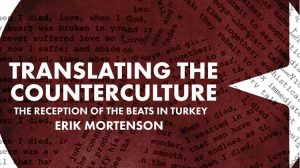March 2015 will mark the occasion of the publication of the third volume of Jack Kerouac works published by Library of America. I took this occasion to catch up with editor, Todd Tietchen, assistant professor of English at University of Massachusetts Lowell. The book is a chronological publishing continuum of the first volume and contains the groundbreaking novel Visions of Cody, the mystic meditation of Visions of Gerard, and lastly, Big Sur.
Is there a schedule by Library of America toward publishing Kerouac’s works?
I can’t really speak for Library of America’s schedule for publishing the remaining Kerouac novels. I simply don’t know. I am editing another Kerouac volume for them, O Rich and Unbelievable Life!: Uncollected Prose Writings of Jack Kerouac, scheduled for publication in September 2016. Some highlights of that volume include: I Wish I Were You; Memory Babe; The August-November 1951 VA hospital journal; and English translations of La Nuit est Ma Femme and Sur Le Chemin (trans. by J.C. Cloutier of UPenn, who also discovered the manuscript of the lost Claude McKay novel).
This volume shall constitute a major contribution to the public corpus of Kerouac’s work, and I think more generally that the association with Library of America helps affix Kerouac with an authorial legitimacy that many still seem hesitant to acknowledge. I don’t know if that also speaks to my “overall intention” in participating in these editorial projects, though I do see the canonization they connote as worthy of effort and care, and hoped to present these works in the best possible light (as did everyone else involved).
I believe that Kerouac was one of the most important experimental American writers of the Cold War period, that his influence resonates throughout U.S. expressive culture in ways that have yet to be properly acknowledged, and I hope that these volumes might help foment such an acknowledgement.
Was there a concern to create an “established text” such as that prepared by Noel Polk with Faulkner? What was your overall intention going forward when editing this volume?
In terms of the Visions of Cody, etc., volume, the goal was to publish authoritative texts of all three works, along with critical apparatus (endnotes, character key) that could support the needs and curiosities of general readers, Kerouac aficionados, and scholars, which I suppose is to say that it’s a scholarly project conceived for a general readership (LoA’s guiding public humanities goal as I understand it). I also think the volume is particularly well-suited for use in university classrooms.
Which novel posed the biggest challenge in preparation of notes? Why?
Visions of Cody was the most challenging volume. As you’re already aware, the Tape section alone is thick with literary, musical, pop cultural, and philosophical allusions. As challenging as documenting those allusions might have been, they also opened Kerouac to me in this new way, as I got to see the breadth of his influences and interests with the objectivity characteristic of bibliographic and textual scholarship.
Visions of Cody also required the most attentive line-by-line editing as a result of its publication history. While the grounding text for this edition is the ’72 publication, there were some differences between that edition, the Laughlin edition, and the typed manuscript in the Berg Collection. Those were my three orienting texts and some changes were made to the ’72 based on the Laughlin and manuscript.
Here are three examples of those changes. First, Laughlin typeset Kerouac’s dashes in a markedly different fashion than the ’72 edition. Based on Kerouac’s typing style in the manuscript, and the fact that Kerouac was alive and involved in the New Directions edition, a decision was made to try to replicate Laughlin’s dashes as closely as possible. Second, the abstract drawing has been printed upside-down for years, since the ’72 version. It was rotated back to its original coordinates (180 degrees) as Kerouac inserted it within his typescript. Finally, Kerouac used rows of dollar signs throughout the typescript as editorial directions (marking section breaks). They were not to be printed in the actual text. Yet for some reason, early on in the ’72 edition (and subsequent editions) a line of oversized dollar signs was printed early on in the text as if it was a textual element (around page 21 or so). There’s no justification for this; it was an (overly enthusiastic?) editorial error that has been perpetuated in the subsequent editions. So that has also been eliminated. As we’ve discussed before, I’ve also wondered whether the misconceptions of Kerouac as “anything goes improvisatory word-slinger” contributed to a history of editorial/typographical errors across his published corpus.
The other two books had a more stable publication history and I tried to adhere to their first editions (including reinserting the illustrations into Gerard, as I think they’re important to the text’s history and to the reader’s experience of the text). Some alterations were made to both (corrections of typographical errors) and those are spelled out in the “Notes on Texts” section.






Leave a Reply